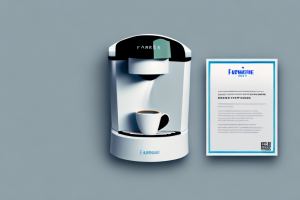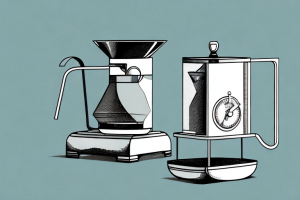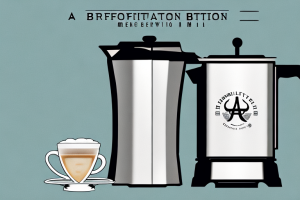Mold In Coffee Maker

A coffee maker with visible mold on the outside
For many people, a cup of coffee is an important part of their daily routine. A freshly brewed cup can be the perfect way to start the day, but what happens when your coffee maker becomes a breeding ground for mold? Not only does it affect the quality of your coffee, but it can also be a health hazard for you and your family.
The Risks of Mold Growth in Coffee Makers
Mold is a fungus that grows in damp and humid environments. As coffee makers produce moisture, they can be a prime location for mold to grow. After brewing a pot of coffee, if the water is left to sit in the reservoir for an extended period, it can create a perfect breeding ground for mold to thrive.
The issue is that when you’re unaware of the mold in your coffee maker, you continue to use it, exposing yourself to health risks. Mold spores can cause allergic reactions such as sneezing, coughing, and itchy eyes. In severe cases, it can lead to respiratory problems, especially for those with asthma or weakened immune systems.
To prevent mold growth in your coffee maker, it’s essential to clean it regularly. You can use a mixture of vinegar and water to clean the reservoir and the internal components of the coffee maker. It’s also crucial to let the coffee maker dry completely after each use to prevent moisture buildup. By taking these simple steps, you can ensure that your coffee maker remains mold-free and safe to use.
Causes of Mold Growth in Coffee Makers
Several factors contribute to mold growth in coffee makers. One of the main reasons is the lack of cleaning. Not regularly cleaning your coffee maker allows mold to grow and spread throughout the machine. Another common cause is the use of unfiltered water. Minerals in unfiltered water can create a film that provides a carbon source for mold to grow on.
Additionally, if you don’t allow your coffee maker to dry out between uses, it can increase the risk of mold growth. Water sitting in the reservoir creates a damp environment that mold can thrive in, and if the moisture builds up, it can create the perfect conditions for mold growth.
Another factor that can contribute to mold growth in coffee makers is the use of old or expired coffee grounds. Old coffee grounds can become moldy and when used in a coffee maker, can transfer the mold spores to the machine. It is important to always use fresh coffee grounds and to properly store them in an airtight container to prevent mold growth.
Symptoms of Mold Exposure from a Coffee Maker
Exposure to mold spores can cause various symptoms, ranging from mild to severe. Common symptoms include sneezing, coughing, itchy or watery eyes, runny nose, and skin irritation. In severe cases, mold exposure can lead to respiratory problems, wheezing, shortness of breath, and asthma attacks.
In addition to the physical symptoms, mold exposure can also have an impact on mental health. Studies have shown that exposure to mold can cause mood swings, depression, and anxiety. This is because mold produces mycotoxins, which can affect the central nervous system.
It is important to note that some people may be more sensitive to mold than others. Those with weakened immune systems, allergies, or asthma may experience more severe symptoms. If you suspect that your coffee maker has mold, it is recommended to stop using it immediately and have it professionally cleaned or replaced.
How to Clean Your Coffee Maker to Prevent Mold Growth
The best way to prevent mold growth in your coffee maker is to clean it regularly. To begin, mix equal parts white vinegar and water, and pour the solution into the reservoir. Run the coffee maker as you would when making coffee, but without coffee grounds. Once the cycle is complete, discard the vinegar solution and refill the reservoir with fresh water. Run another cycle to rinse the machine thoroughly.
Another option is to use a specialized coffee maker cleaner that’s designed to remove mold and other buildup. Follow the manufacturer’s instructions on how to use it, and remember to rinse the machine thoroughly afterward.
In addition to regular cleaning, there are a few other steps you can take to prevent mold growth in your coffee maker. First, make sure to empty the carafe and remove any leftover coffee grounds after each use. This will prevent moisture from building up and creating a breeding ground for mold. Additionally, consider using filtered water in your coffee maker. Tap water can contain minerals and other impurities that can contribute to mold growth.
If you notice mold growing in your coffee maker despite regular cleaning, it may be time to replace it. Mold can be difficult to completely remove, and if it has spread to the internal components of the machine, it may be impossible to fully eliminate. Investing in a new coffee maker may be the best way to ensure that your morning cup of joe is mold-free.
Natural Remedies for Cleaning a Moldy Coffee Maker
If you prefer natural remedies, there are various options for cleaning a moldy coffee maker. For example, you can use a mixture of lemon juice and salt to clean the machine. To begin, fill the reservoir with water and add a mixture of 1/3 cup lemon juice and 1 tablespoon salt. Run the machine as you would when making coffee, but without coffee grounds. Once the cycle is complete, discard the solution and rinse the machine thoroughly with clean water.
Baking soda is another effective natural solution for cleaning a moldy coffee maker. Mix ¼ cup of baking soda with enough water to create a paste. Spread this mixture on the inside of the machine and let it sit for around 15 minutes. Rinse the machine thoroughly with clean water.
The Best Cleaning Products for Removing Mold from Your Coffee Maker
There are various cleaning products on the market designed specifically to remove mold and other buildup from coffee makers. These products typically contain a combination of citric acid and other ingredients that break down mold and other residue.
A popular option is a coffee maker cleaner from a trusted brand like Keurig or Mr. Coffee. They’re easy to use and come with clear instructions on how to clean your machine thoroughly.
The Importance of Regularly Cleaning Your Coffee Maker
One of the essential things you can do to keep your coffee maker clean and free from mold is to clean it regularly. Depending on how frequently you use it, you should aim to clean it every 2-4 weeks. The longer you leave it between cleanings, the more likely you are to encounter mold.
Remember, that cleaning your coffee maker not only keeps it free from mold but also helps your coffee to taste better. A clean machine helps to remove the build-up of old coffee oils and residue that can affect the flavor of your coffee.
How to Disinfect Your Coffee Maker
To disinfect your coffee maker, you can use a solution of bleach and water. Mix one part bleach to four parts water and pour the solution into the reservoir. Run a cycle as you would when making coffee, but without coffee grounds. Discard the bleach solution and rinse the machine thoroughly with clean water.
Alternatively, you can use a hydrogen peroxide solution to disinfect your coffee maker. Mix equal parts water and hydrogen peroxide, and pour the solution into the reservoir. Run a cycle as you would when making coffee, but without coffee grounds. Discard the solution and rinse the machine thoroughly with clean water.
Can You Drink Coffee from a Moldy Machine?
Drinking coffee made from a moldy machine is not recommended. Moldy coffee makers can produce toxins that can be harmful to your health. Ingesting these toxins can cause various health problems, such as respiratory problems, allergic reactions, and even toxicity that can affect the liver and kidneys. It’s essential to clean your coffee maker regularly to prevent mold from growing.
Signs that Your Coffee Maker Needs to be Replaced
Most coffee makers can last for several years with proper maintenance. However, there are signs that your coffee maker may need to be replaced. If you notice that your coffee maker is leaking or has a strange smell or taste, it could be a sign of mold and bacteria growth. Other signs include rust or buildup that can’t be cleaned, or if the machine fails to operate correctly.
How Often Should You Replace Your Coffee Maker?
The lifespan of a coffee maker depends on several factors, such as the frequency of use and the quality of maintenance. However, most machines last for around 5-7 years with proper care. If your coffee maker is showing signs of wear and tear or isn’t functioning correctly, it may be time to consider replacing it. Additionally, if you frequently encounter mold, it could be a sign that your coffee maker needs to be replaced.
Best Practices for Maintaining a Clean and Safe Coffee Maker
To keep your coffee maker running smoothly and ensure that it’s free from mold and bacteria, follow the best practices below:
- Clean your coffee maker regularly
- Use a water filter to prevent buildup
- Allow your coffee maker to dry out between uses
- Never leave water in the reservoir for an extended period
- Remove used coffee grounds and clean the filter basket after each use
- Consider using specialty coffee machine cleaners
The Connection Between Mold and Poor Indoor Air Quality
Mold growth is a significant contributor to poor indoor air quality. When mold spores are present, they can spread throughout your home, leading to respiratory problems and allergic reactions. To prevent mold growth, it’s essential to maintain a healthy level of humidity in your home and regularly clean surfaces where moisture can accumulate.
Tips for Preventing Mold Growth in Other Kitchen Appliances
Mold is not just limited to coffee makers. Other kitchen appliances, such as refrigerators and dishwashers, can also provide a suitable environment for mold to grow. To prevent mold growth, follow these tips:
- Clean appliances regularly
- Avoid leaving food residues or spills for an extended period
- Ensure that appliances are adequately ventilated
- Keep the humidity level in your home below 50%
Common Misconceptions About Cleaning a Coffee Maker
There are various common misconceptions about cleaning a coffee maker. For example, many people believe that using soap and water is enough to keep the machine clean. However, soap can leave a residue that can affect the taste of your coffee. Additionally, using cleaning solutions that are not specifically designed for coffee makers can be harmful to the machine and reduce its lifespan.
Expert Advice on Dealing with Mold in Your Home
If you encounter mold in your home, it’s essential to address it quickly to prevent it from spreading. When dealing with mold, it’s best to seek out expert advice from a professional who specializes in mold remediation. They can determine the extent of the problem, identify the type of mold, and provide effective solutions to remove it safely.
Understanding the Health Risks Associated with Exposure to Mold Spores
Mold spores can cause various health problems, especially for those with weakened immune systems, allergies, or respiratory problems. Exposure to mold can cause allergic reactions such as sneezing, coughing, and itchy eyes. In severe cases, it can lead to respiratory problems and asthma attacks. It’s essential to take mold growth seriously and address it quickly to protect yourself and your family.
Final Thoughts
Mold growth in your coffee maker is a serious issue that can have adverse effects on your health. Regular cleaning, using filtered water, and allowing your machine to dry out between uses can help to prevent mold growth. If you notice signs of mold, it’s essential to address it quickly to prevent it from spreading. By following the tips outlined in this article, you can maintain a clean and safe coffee maker, ensuring that you can enjoy a fresh cup of coffee without any health risks.



